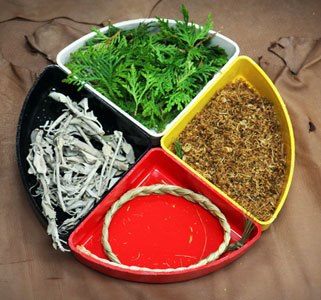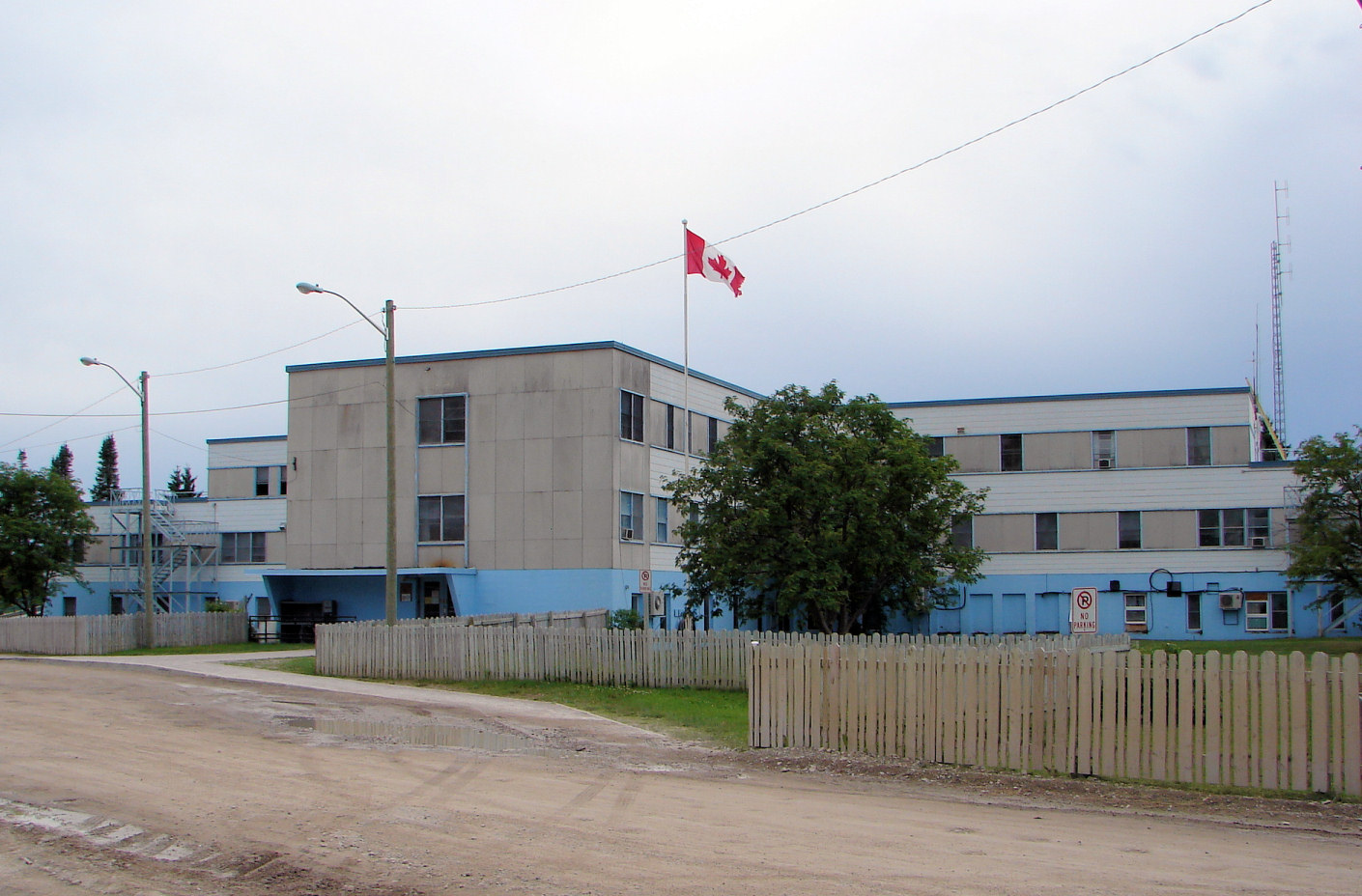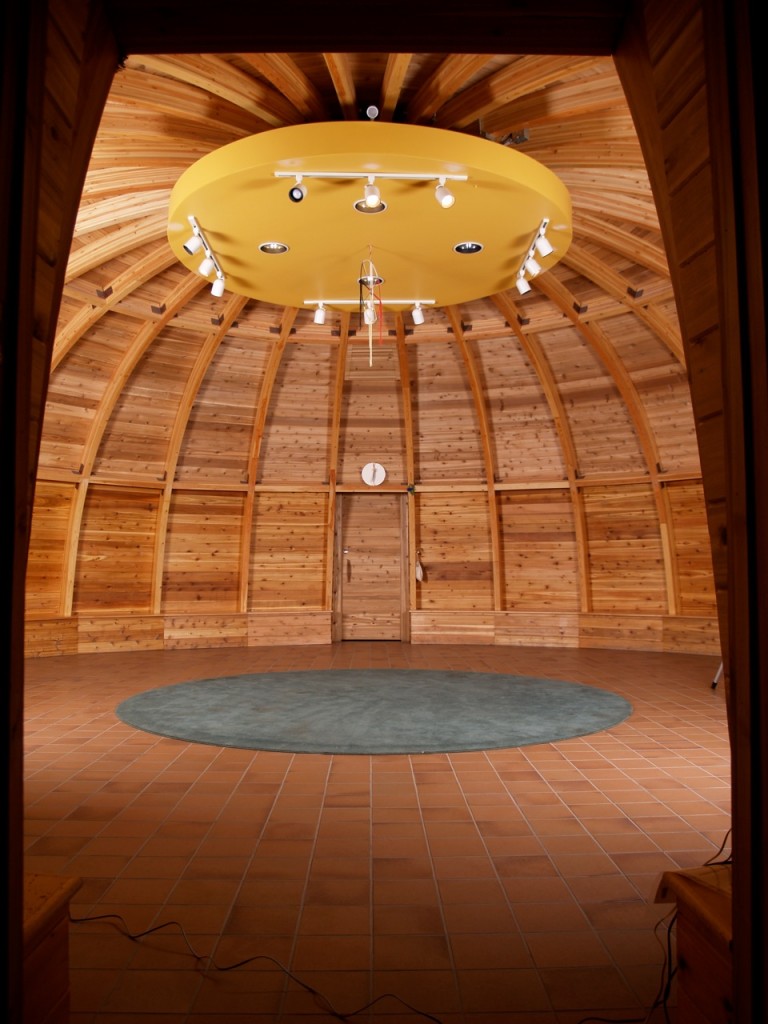Session 3: Customs, Protocols and Engaging with the Northern Aboriginal Communities
Introduction
 An Anishnaabe Medicine wheel with medicines. Clockwise from right: tobacco, sweetgrass, sage, cedar.
An Anishnaabe Medicine wheel with medicines. Clockwise from right: tobacco, sweetgrass, sage, cedar.
Credit: Wabano Centre for Aboriginal Health (©)
Welcome to Session 3: Customs, Protocols and engaging with the northern Aboriginal communities.
This session addresses the variety of customs and protocols inherent in northern Aboriginal communities. You will explore the complex nature of providing health and social service in urban, rural, remote settings. Learning about this will help you to understand how to engage effectively with each community. You will be provided with some basic guidelines to enable a meaningful experience with health care service providers, patients, health educators and Traditional Medicine practitioners.
Intended Learning Outcomes
- Introduction to Cultural Competence and Cultural Safety and Security
Elements of Performance- Recognize and articulate the role of the core competencies in the provision of culturally safe health and human care for First Nation, Inuit, and Métis Peoples’
- Distinguish and define cultural awareness, cultural sensitivity, cultural competence, and cultural safety and security
- Identify the challenges and barriers for Indigenous peoples in northern Ontario
Elements of Performance- Identify barriers that impact on therapeutic communication with northern Aboriginal Peoples’
- Review the various Telehealth platforms and their influence on health care and health service delivery in northern Aboriginal communities
- Understand the role of the Truth and Reconciliation Commission
- Understand the role of Traditional Aboriginal medicine in northern Aboriginal communities
- Review the principles of ethical Aboriginal research methods used in northern Ontario First Nations
- Demonstrate respectful relationships and create strategies for strengthening relationships with Aboriginal clients, families and communities, Elders, Aboriginal medicine people, Chiefs and Councils, Health Directors, Health Authorities and Tribal Councils. Elements of Performance
- Articulate current issues that affect First Nations, Métis and Inuit Peoples’
- Identify principles of developing collaborative and ethical relationships with First Nation, Inuit, and Métis clients, their families, and communities
- Recognize the importance of creating teaching and learning environments where First Nation, Inuit, and Métis Peoples’ health care professionals and clients feel safe to freely express ideas, perspectives, and critical thoughts
Self-Assessment and Goal Setting
 Weeneebayko General Hospital
Weeneebayko General Hospital
Credit: P199 (CC BY-SA 3.0)
This is a short reflective activity that can be shared as part of the Sharing Circle blog/synchronous discussion forum that will be held during this session.
Think about the first time you will be going to a First Nations community as a health care practitioner. How are you going to prepare?
Other things to think about: What are the “Calls to Action” from the Truth & Reconciliation report that apply to you? What does “traditional medicine” mean in the Aboriginal context?
Use the Note to Self activity worksheet to keep notes as you work through the material. This worksheet will be really helpful during the Sharing Circle discussion. Make sure you keep track of the questions you may have about the material as there will be opportunities for sharing during the Sharing Circle.
Reading Room
 Interior of Medicine Lodge in Anishnawbe Mushkiki Aboriginal Health Centre.
Interior of Medicine Lodge in Anishnawbe Mushkiki Aboriginal Health Centre.
Credit: Anishnawbe Mushkiki Aboriginal Health Centre (©)
1. Access to Physiotherapy for Aboriginal Peoples’ in Canada1
2. Integrating traditional medicines into Western medical treatment2
3. Assessing the Institutionalization of Traditional Aboriginal Medicine3
4. Traditional Knowledge Primer: Respecting our Ancestors, ensuring our Future4
Web-quest
Search “Ethical guidelines for Aboriginal research”
Media Resources
5. Darrell Dennis on RevisionQuest: Everything you wanted to know about Native people but were afraid to ask5 (CBC radio – audio, 27:31 minutes)
6. Darrell Dennis: The Elder6 (CBC radio – audio, 27:30 minutes)
7. Aboriginal Cultural Safety: colonial and post-colonial policies7 (5:03 minutes)
- This video looks at the colonial and post-colonial policies that have negatively impact the health of Canada's Aboriginal people
8. Creating Healthy Community Patterns with Chief Mark Wedge8
9. Witness Blanket9
- Also available as an iTunes app
Learning Activities
Activity 1:
Facilitated Sharing Circle: Note to Self! Take a moment to reflect on what you have learned in this session.
What are your thoughts and feelings about what you learned and how it applies to your role as a health advocate and your future practice whether located in a tertiary care metropolitan city or small community? Complete the Note to Self worksheet and come prepared to share your insights during the facilitated discussion forum.
Activity 2:
Aboriginal Peoples’ in the News
Activity 3:
Discharge Planning Case Study
Sneak Peek
In Session 4, we will work towards building cultural competence to help you feel more confident as a health service provider.
References
1 Canadian Physiotherapy Association. (2014). Access to physiotherapy for Aboriginal peoples in Canada. Accessed from http://www.physiotherapy.ca/Advocacy/Legislation/Physiotherapy-and-Aboriginal-Health-in-Canada
2 National Aboriginal Health Organization. (2012). Integrating traditional medicines into Western medical treatment. Accessed from http://www.naho.ca/publications/
3 Williamson, P., & Manitowabi, D. (2009). Assessing the Institutionalization of Traditional Aboriginal Medicine. Accessed from http://www.noojmowin-teg.ca/SitePages/Home.aspx
4 Chiefs in Ontario. (2010). Respecting our ancestors, ensuring our future: Traditional knowledge primer for First Nations. Accessed from http://www.chiefs-of-ontario.org/
5 Dennis, D. (2011). ReVision Quest: Everything you wanted to know about Native people but were afraid to ask. Accessed from http://www.cbc.ca/player/play/2111608165
6 Dennis, D. (2011). ReVision Quest: The Elder. Accessed from http://www.cbc.ca/player/play/2042306562
7 Anishnawbe Health Toronto. (2012). Aboriginal Cultural Safety: colonial and post-colonial policies. Accessed from https://www.youtube.com/watch?v=vQZv2VIjep8
8 Wedge, M. (2008). Creating healthy community patterns with Chief Mark Wedge. Accessed from https://www.youtube.com/watch?v=eKjE8EtsF84
9 The Witness Blanket Project. (2015). Witness Blanket – a National Monument to recognize the atrocities of Indian Residential Schools. Accessed from http://witnessblanket.ca/